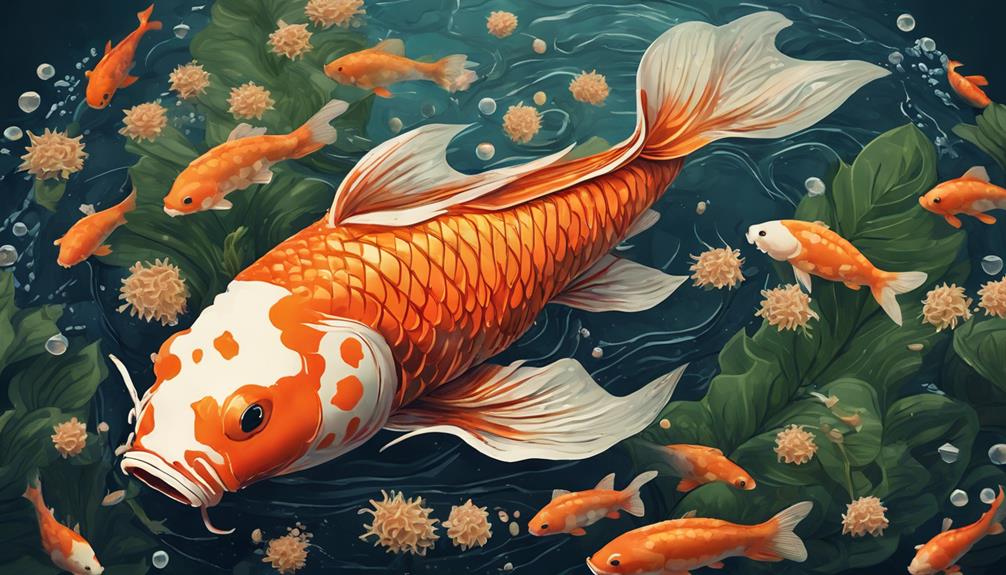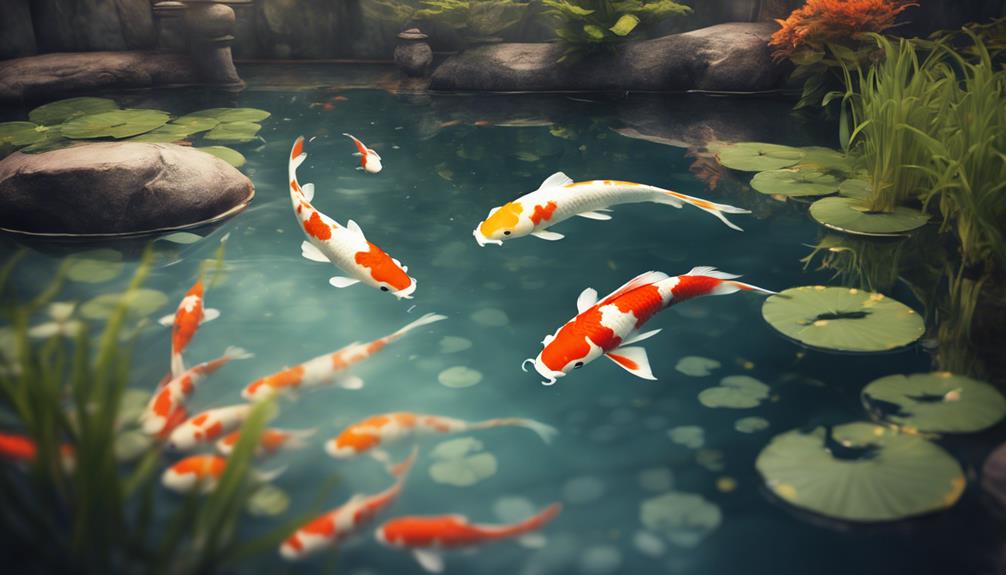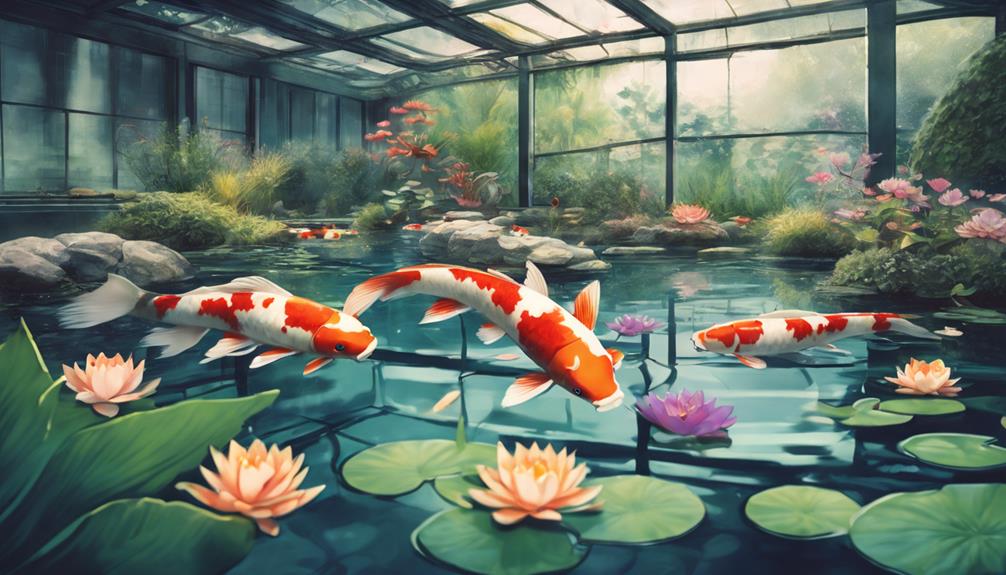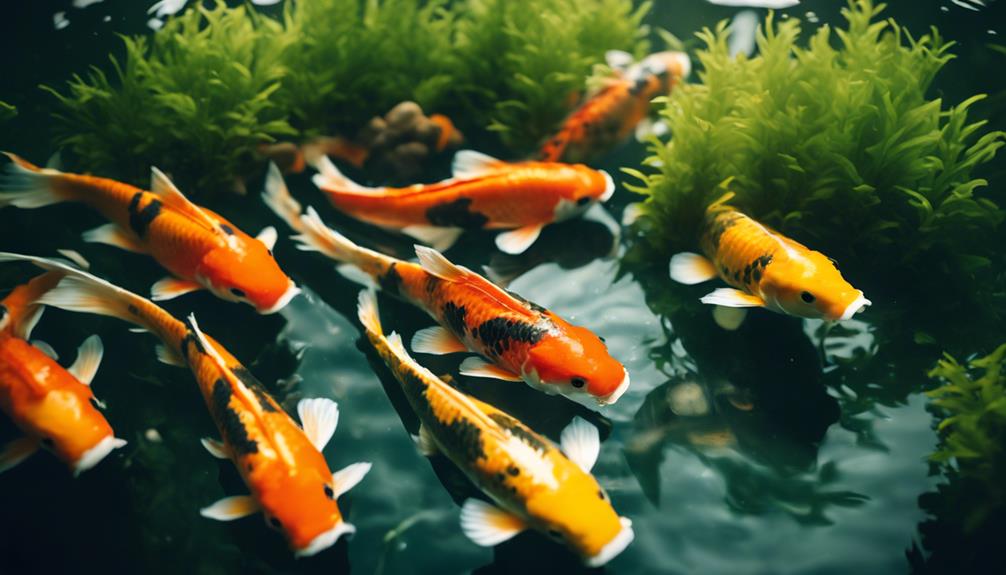You can dramatically boost your koi's growth rate and overall health by focusing on proven breeding techniques, meticulous stock selection, and a deep understanding of the complex interplay between genetics, environment, and nutrition. Start by selecting koi with vibrant colors, attractive patterns, and sturdy body shapes, and prioritize same-species breeding to minimize genetic defects. Maintain exceptional water quality, stable pH levels, and ideal oxygen levels to create a superior breeding environment. By implementing these techniques, you'll be well on your way to releasing your koi's full growth potential – and there's even more to discover.
Table of Contents
Key Takeaways
- Select breeding stock with vibrant colors, attractive patterns, and sturdy body shapes to increase the likelihood of producing high-quality offspring.
- Feed selected koi a high-protein diet for several weeks to boost fertility and increase the chances of successful spawning.
- Maintain exceptional water quality control and stable pH levels to create a superior breeding environment.
- Quarantine and test breeding stock for diseases and parasites to prevent transmitting health issues to the next generation.
- Provide protein-rich diets and ideal feeding schedules to boost koi growth and maximize muscle development.
Selecting Healthy Breeding Stock
When selecting healthy breeding stock, you should prioritize koi that exhibit vibrant colors, attractive patterns, and a sturdy body shape, as these desirable characteristics will increase the likelihood of producing high-quality offspring.
This is vital in koi breeding, as champion Koi are bred from parents with exceptional traits.
To guarantee the best possible outcome, choose koi of the same species to minimize genetic defects and strengthen the immune system of your future offspring.
You can either purchase breeding stock from a reputable breeder or select from your existing stock that has been raised in a healthy environment.
Before breeding, feed your selected koi a high-protein diet for several weeks to boost fertility and increase the chances of successful spawning.
It's also essential to quarantine and test your breeding stock for diseases and parasites to prevent transmitting health issues to the next generation.
Optimal Breeding Environment
When creating a superior breeding environment, you'll want to focus on maintaining exceptional water quality control and stable pH levels.
You can achieve this by implementing a reliable filtration system and performing regular water changes to prevent contamination and disease outbreaks.
Water Quality Control
By creating a prime breeding environment through stringent water quality control, you can release your Koi's growth potential and set them up for success.
To achieve this, making it crucial to maintain ideal water parameters that support healthy Koi growth.
Regular water changes can help maintain pristine water parameters, which are vital for fast Koi growth.
Verify oxygen levels are at their peak, ranging from 12°C to 23°C, to support maximum bacterial growth in the filter and your Koi's digestive system.
Invest in a well-designed filtration system, including components like Bakki Showers, to provide pristine water parameters.
Regularly test water quality to verify parameters like ammonia, nitrites, and pH are stable and at their best.
Stable Ph Levels
Maintaining stable pH levels is crucial in creating a perfect breeding environment, as fluctuations can stress your Koi and hinder their growth potential.
You want to guarantee your Koi thrive, and pH levels play a critical role in their overall health.
A stable pH range between 6.5 and 8.5 allows your Koi to absorb nutrients from their koi foods efficiently, promoting healthy growth and development.
Fluctuations in pH levels can cause stress, leading to compromised koi health and increased susceptibility to diseases.
When feeding koi, monitoring water pH levels is imperative to prevent sudden changes.
You can use pH test kits or pH meters to regularly check the water's acidity or basicity.
Make adjustments as needed to maintain a stable pH range.
Nutrition and Feeding Strategies

When it comes to boosting koi growth, you'll want to focus on protein-rich diets and ideal feeding schedules.
You'll need to provide your koi with the right amount of nutrients at the right time to support rapid growth and development.
Protein-Rich Diets
To fuel your koi's growth and maximize muscle development through a strategic feeding approach, the answer lies in protein-rich diets.
To boost koi growth, you need to provide your fish with a diet that's rich in protein, vitamins, and minerals.
Feed high-protein food: Offer koi food with a protein content of 5% or more of their body weight per day, broken up into multiple feedings.
Focus on frequent, small meals: Instead of feeding your koi a few large meals, opt for 30 small meals a day to provide constant nutrition and peak growth.
Add variety with high-protein treats: Supplement their staple food with protein-rich treats like silkworm pupae to provide a varied diet and support ideal growth.
Encourage snacking: Feed your koi in multiple locations, such as a feeding ring, to encourage snacking and provide constant nutrition, leading to faster growth rates.
Optimal Feeding Schedules
By strategically planning your koi's feeding schedule, you can release their full growth potential and maximize muscle development. To achieve this, it is crucial to focus on the frequency of feeding rather than the amount of food given. Experts recommend up to 30 feedings per day for ideal koi growth.
| Age | Feedings per Day | Amount of Food |
|---|---|---|
| Fry (0-3 months) | 10-15 | 1-2% of body weight |
| Juvenile (3-6 months) | 15-20 | 2-3% of body weight |
| Adult (6+ months) | 20-30 | 3-5% of body weight |
| Additional Snacks | – | High-protein snacks like silkworm pupae |
Remember to provide constant nutrition by feeding small, frequent meals, and consider offering high-protein snacks in addition to staple food. You can also encourage snacking and provide mental stimulation by feeding in multiple locations, like a feeding ring. By following these guidelines, you'll be well on your way to promoting healthy koi growth and maximizing muscle development.
Genetics and Growth Factors
Your koi's genetic makeup substantially influences its growth rate, with certain breeds naturally predisposed to faster development, such as Chags, which can outpace others by a considerable margin.
As a koi enthusiast, you want to guarantee your Japanese Koi reaches its full growth potential. To do this, you need to focus on quality koi genetics, which can result in impressive growth rates of up to 60cm for most koi and ponds.
Monitor your koi's growth: Nisai (2-year-old) koi should reach 50cm+ in length. Keep an eye out for unusual skin conditions, lesions, or bulging eyes, which can indicate health issues.
Provide quality food: Feed your koi high-quality food that meets their nutritional needs, promoting healthy growth and development.
Regularly inspect your koi: Regular monitoring of koi behavior is vital for early detection of health issues.
Maintain a healthy environment: Verify your pond's water quality is ideal, and perform regular maintenance to prevent mucus buildup in filters and pipes.
Environmental Influences on Growth

As a koi enthusiast, you're likely aware that your koi's growth rate is heavily influenced by their environment.
Five key environmental factors – water quality, temperature, pond size, water depth, and aquatic vegetation – substantially impact your koi's growth rate.
You need to guarantee that your koi pond provides prime conditions for growth.
Poor water quality, for instance, can cause stress and stunt your koi's growth.
On the other hand, a well-maintained pond with good water circulation and quality can help your koi thrive.
Temperature also plays a vital role, with koi needing temperatures between 50°F and 86°F to grow at their best.
A larger pond with adequate water depth can also support healthier koi growth, as it provides more space for your koi to swim and exercise.
Finally, aquatic vegetation can provide shelter and food for your koi, promoting their overall health and growth.
Debunking Growth Myths and Misconceptions
While optimizing environmental conditions is vital for koi growth, it's equally important to separate fact from fiction when it comes to common myths and misconceptions that can hinder your koi's development. As you aim to boost your koi's growth, it's imperative to debunk these myths to guarantee your fish health and well-being.
Koi grow faster in dirty water: False! Poor water quality can actually stunt your koi's growth and lead to health issues. Regular water changes and proper filtration are vital for peak koi growth.
Koi color is determined by their diet: Not entirely true! While diet can influence koi color, genetics play a significant role in determining their color pattern and intensity.
Koi can grow as fast as you want them to: Sorry, but no! Koi growth is influenced by genetics, environment, and nutrition, and there's a limit to how fast they can grow.
All koi varieties grow at the same rate: Nope! Different koi varieties have unique growth rates, so it's imperative to research the specific needs of your koi breed.
Advanced Care and Management Techniques

Implement a robust pond management strategy to create an ideal environment that fosters healthy growth and maximizes your koi's potential. As a dedicated koi breeder, you understand the importance of providing peak conditions for your fish to thrive.
Advanced care and management techniques play a vital role in releasing your koi carp's full potential. You can achieve better food conversion rates by incorporating high-quality Fish meal into their diet, which directly impacts their color and growth.
A well-balanced diet not only enhances their vibrant colors but also promotes a robust body shape. Regular water testing and maintenance guarantee a stable environment, allowing your koi to focus their energy on growth and development.
Frequently Asked Questions
How Can I Make My Koi Grow Faster?
You can boost your koi's growth by selecting genetically superior fish, maintaining ideal water quality through efficient pond filtration, offering a varied diet, and providing a spacious tank with ample room for exercise and exploration.
How Do I Encourage My Koi to Breed?
Get ready to ignite the passion of your koi, just like a medieval knight igniting a dragon's fire! To encourage breeding, you'll need to create ideal water quality, identify spawning triggers, and simulate natural breeding cycles, while considering environmental factors and observing mating rituals.
How Do Koi Fish Get Bigger?
You can maximize your koi's growth by focusing on their genetics, maintaining excellent water quality, optimizing their diet, providing a spacious tank, and simulating a natural habitat, allowing them to thrive and reach their full potential.
What Stunts Koi Growth?
You're wondering what's holding your koi back from reaching their full potential? Imagine a toxic cocktail of foul water quality, genetic defects, poor nutrition, overcrowded tanks, and environmental stress – a recipe for stunted growth, and you're likely to find the culprit among these common growth-stunting culprits.
Conclusion
As you gaze into your thriving koi pond, imagine the vibrant scales glistening in the sunlight, each fish a declaration to your mastery of proven breeding techniques.
With superior breeding stock, environment, and nutrition, you've deciphered the secrets to rapid growth and development.
Now, your prized koi swim strong and healthy, their beauty a reflection of your dedication to the art of breeding.

